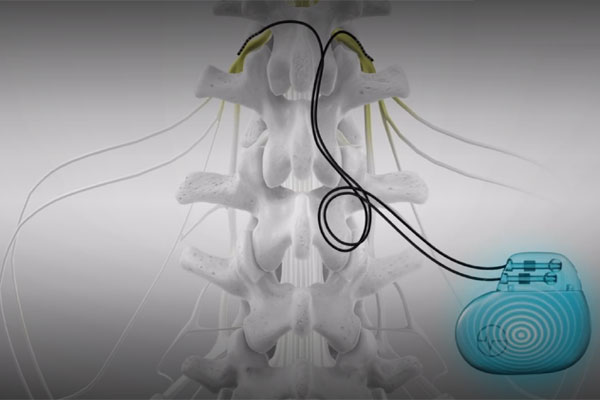 As a leading provider of chronic pain management and treatment, Florida Pain Relief Centers prioritizes the patient experience and results.
As a leading provider of chronic pain management and treatment, Florida Pain Relief Centers prioritizes the patient experience and results.
We recognize that every patient has a unique care journey, making access to a diverse range of innovative, proven therapies critical. Our physicians understand that not all neuropathic chronic pain patients respond to Spinal Cord Stimulation.
To optimize relief and wellness throughout every phase of the care continuum, FPRC’s team of leading neuromodulation experts also offers dorsal root ganglion (DRG) stimulation.
First approved by the U.S. Food and Drug Administration in 2016, DRG stimulation is an innovative, outpatient neuromodulation therapy designed to ease discomfort for people with complex regional pain syndrome in the lower extremities.
More importantly, DRG stimulations offer a viable, minimally invasive care alternative for patients who haven’t received sufficient pain relief from traditional Spinal Cord Stimulation (SCS) or other treatment options.
What You Need to Know about DRG Therapy:
A report in The Journal of the International Association for the Study of Pain published both short and long-term data from an ACCURATE study that evidenced DRG stimulation as a superior therapy over SCS treatment for patients suffering from complex regional pain syndrome.
The dorsal root ganglion serves as a stimuli conduit between the peripheral and central nervous systems, processing all sensory acuity as it travels to the spinal cord. The neurons found in the DRG can modulate sensations before reaching the spinal cord, making stimulation of this nerve cluster an effective treatment approach for chronic pain patients.
Similar to Spinal Cord Stimulation, DRG therapy specifically stimulates the dorsal root ganglion for a more focused pain management practice that targets lower body regions not as easily or effectively treated with conventional spinal cord therapies, including:
- Hands
- Feet
- Abdomen
- Groin
- Hips
- Chest
Recent clinical studies have even indicated that DRG stimulation can be an effective therapy to treat patients experiencing Phantom Limb Pain (PLP), a neuropathic condition often experienced by patients after a limb amputation that can prove challenging to manage using typical pharmaceutical options.
How Dorsal Root Ganglion Therapy Works
DRG stimulation treatment works by implanting a small generator with four thin wire leads under the patient’s skin. Using a handheld control, clinicians emit small electrical pulses to the designated dorsal root ganglion area, effectively blocking the transmission of pain signals that typically travel from the peripheral nervous system to the rich nerves cells of the dorsal root ganglion before ultimately reaching the spinal cord and brain.
Results from the ACCURATE study revealed that DRG group participants demonstrated a higher reduction in pain compared to the SCS group participants throughout the entire study, with the most significant differences at both the 3 and 12-month intervals:
- 3 months (84.1 vs. 70.9)
- 6 months (80.2 vs. 71.7)
- 9 months (80.2 vs. 67.9)
- 12 months (81.4 vs. 66.5)
Beyond lowering discomfort levels, DRG therapy also offers patients suffering from a diverse range of complex pain systems several distinctive treatment advantages, including:
Lower Energy Doses
The thin layer of spinal fluid surrounding the dorsal root ganglion establishes a very thin transmission layer between the DRG and the stimulator, which ultimately requires a lower energy dosage and reduced overall stimulation of the neural network than other traditional therapies.
Easier Application
Unlike other peripheral nerve bundles that have a protective membrane, an easily penetrable connective tissue coating surrounds the DRG, making it an ideal target for neuromodulation applications.
Stimulation Specificity
DRG stimulation offers highly directed and precise anatomical targeting to restrict total stimulation to the pain area. The ACCURATE study revealed that 94.5 percent of DRG patients received focused stimulation in their specific pain area without peripheral paresthesia (pins-and-needles feeling), compared to only 61.2 percent of SCS control group participants.
Minimal Risk for Lead Migration
The dorsal root ganglion occupies a very small space in the body, which can lower the risk of the inserted wire leads migrating off target.
Marginal Body Position Impact
The cerebral spinal fluid surrounding the dorsal root ganglion does not vary when changing body positions. As a result, the DRG stimulation pattern and subsequent pain relief remains constant regardless of whether a patient is upright, lying down, walking, or sitting.
Potential Mood and Activity Improvement
Chronic pain conditions are often associated with disruptions in mood as well as social and emotional functioning. The ACCURATE study showed that, after three months, DRG stimulation patients showed significantly higher improvements in mood disruptions. Additionally, by month 12 same study group also showed greater improvements in physical and social function as well as overall general health when compared to SCS subjects.
Can DRG Therapy Relieve Your Chronic Pain Symptoms?
 At Florida Pain Relief Centers, our expert pain management specialists are dedicated to providing minimally invasive, proven procedures and treatments based in the individual needs of each patient. Our specialists are highly skilled and ready to consult with you to find a customized solution based on your situation and the nature of your pain.
At Florida Pain Relief Centers, our expert pain management specialists are dedicated to providing minimally invasive, proven procedures and treatments based in the individual needs of each patient. Our specialists are highly skilled and ready to consult with you to find a customized solution based on your situation and the nature of your pain.
Call us today at (800) 215-0029 to schedule a consultation or click the button below to set up a consultation online at one of our clinics so we can discuss whether DRG Therapy, or another effective treatment option, can restore you to a quality of living with less pain.

